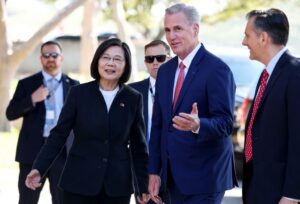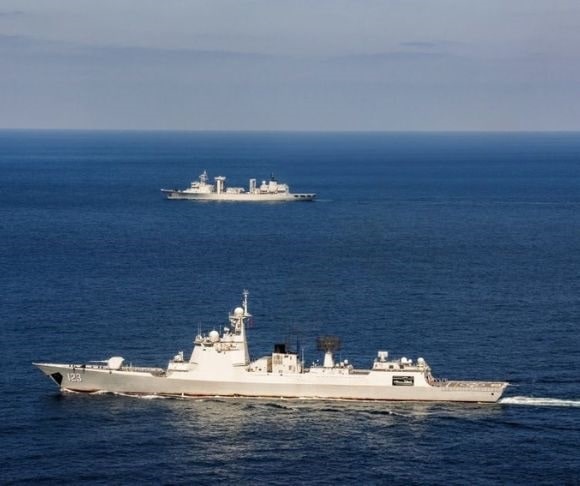Wednesday, April 5, the People’s Republic of China (PRC) sent a fleet of naval warships close to the island of Taiwan. The People’s Liberation Army Navy (PLAN) task force was led by the Shandong, one of its three aircraft carriers. The PLAN’s aggressive naval maneuver through the Bashi Channel between Luzon, the Philippines, and Taiwan demonstrated Beijing’s displeasure over Speaker of the House Kevin McCarthy (R-CA) and other US officials meeting with Taiwan President Tsai Ing-wen. The most recent reestablishment of military-to-military training with the Philippines does not sit well with China, either.
Tsai received a briefing while visiting Belize from her senior security officials on Tuesday (April 4, 2023) regarding the PLAN exercising naval forces near Taiwan’s waterways. A statement by the Taipei government said President Tsai was brought up to date on the unfolding Chinese operations. “The president asked relevant units to continue to grasp the surrounding situation, and to enable the visiting delegation to continue to grasp the situation in real-time,” the statement explained, according to Fox News.
China Threats Don’t Stop Meetings
The Global Times, a propaganda news source for the CCP, was quick to explain the presence of the Beijing battle group. The publication said:
“Ahead of a planned meeting between Taiwan regional leader Tsai Ing-wen and Speaker McCarthy in California on Wednesday, the Chinese People’s Liberation Army (PLA) Eastern Theater Command vowed to safeguard national sovereignty and territorial integrity, with multiple land, naval, air exercises focusing on amphibious landing missions underway.”
There is some confusion on the part of the CCP if it believes the United States government takes directions from Beijing on which foreign dignitaries with whom it may or may not have meetings or diplomatic discussions. Nevertheless, if the war-like intrusion into waters near Taiwan was intended to intimidate the Taipei government, the PLAN naval drills missed the mark. Speaker of the House Kevin McCarthy (R-CA) met with President Tsai at the Ronald Reagan Presidential Library, where the speaker reaffirmed the close ties between the US and Taiwan. “Here at the Reagan Library, exhibits show Reagan’s belief in democracy and commitment to the ideas of peace and freedom. Those values serve as the bedrock of our friendship with the people of Taiwan. And they are more important now than ever before,” McCarthy tweeted.
The meeting between McCarthy and Tsai took place as planned, and President Tsai also met with a bipartisan group of US senators during her trip. While on a layover in New York City, Tsai had a meeting with Senators Dan Sullivan (R-AK), Joni Ernst (R-IA), and Mark Kelly (D-AZ) where the US officials expressed “support for the island’s democracy and touting legislation that would impose stiff economic and financial sanctions against China if it invaded Taiwan,” according to The Wall Street Journal. Additionally, the PRC has been critical of recent military-to-military exercises between the US and the Philippines.
Philippines Allows US Military Basing to Thwart China

Tsai Ing-wen and Kevin McCarthy (Photo by Mario Tama/Getty Images)
“The Philippines has pulled off a diplomatic U-turn, reviving its traditional defense ties with Washington years after spurning it in favor of Beijing…Manila believes a robust partnership with Washington can help it stop China from trampling on its rights in the South China Sea, analysts said,” according to Allison Jackson, writing for AFP (Agence France Presse). What that partnership looks like is an agreement between the US and Philippine governments to work more closely to establish mutually beneficial national security objectives. The Philippine government has identified nine military camps and bases where US military units will stay on a rotational basis. The installations run the length of the Philippine Islands. What has the Chinese upset are the two northernmost installations, the Naval Base Camilo Osias and the Lal-Lo Airport.
“Those two locations have infuriated Chinese officials because they would provide US forces with a staging ground close to southern China and Taiwan, the self-ruled island Beijing claims as its own,” Jim Gomez wrote for Associated Press. US forces stationed near Taiwan are not the only reason Philippine President Ferdinand Marcos Jr. has agreed to bring US military forces back into his country. Two other bases of the nine in the western province of Palawan are located on the South China Sea, a significant trade route to which the PRC has staked a claim and threatened smaller nations who also have claims to the sea lanes, including the Philippines. Having the US as a presence in the region sends a strong message. The US warfighting commanders in the Indo-Pacific region have long advocated for a greater American presence. Being back in the Philippines is a good start.
President Tsai’s successful and consequential visit with US leadership combined with the US-Philippine agreement allows the US to stand a little taller against the Beijing bluster. It’s always a good contest when the score is US: 2, China: 0.
The views expressed are those of the author and not of any other affiliation.




